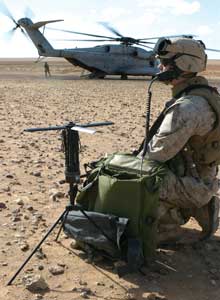Network science project


Connecting state and local government leaders
Transforming the Defense Department into an integrated, globally networked organization will cost between $30 billion and $50 billion and be as challenging asthe Manhattan Project. And it is a long way from becoming a reality. Those are two key findings of <i>Network Science 2006</i>, a report ordered by the Army's director of research and laboratory management.

CONTROL: One of the principles of military command networking is getting autonomous action to the lowest possible level.
CPL. Christopher R. Rye, U.S. Marine Corps.
Those are two key findings of Network
Science 2006, a report ordered
by John Parmentola, the
Army's director of research and
laboratory management. Prepared
by the National Research Council's
Committee on Network Science for
Future Army Applications, the report
found that contemporary military
success 'depends on the development
of a coherent system of
interacting networks using a rapidly
evolving enabling technology.'
The goal is linking the key elements
of network transformation'command,
control, communications,
computers, intelligence, surveillance
and reconnaissance (C4ISR).
'You've got to start thinking about [net-centricity]
as a 'Manhattan Project' where you just
absolutely insist that you get this design done
at a global level.' JOHN DUKE, NATIONAL RESEARCH COUNCIL
Today, the report said, networks are not
being quickly and efficiently linked to ground
and air elements'such as artillery locating
systems, all-weather assets, and persistent
surveillance and dissemination systems.
While 'C4ISR systems and technologies
provide a manifold improvement in combat
capabilities, they provide a manifold problem
of complexity,' according to the report.
Some of those challenges include:
- Incompatibility of newer C4ISR components
with rapidly aging legacy systems - Ever-evolving, increasingly complicated
technology and its impact on humans - Shortage of radio frequency bandwidth
for net-centric operations.
John Duke, an NRC member and senior
research fellow, said a networked military
cannot become reality without massive rethinking
of the warfare-operations nexus.
He said the committee's brief was 'determining
the substance of what might be
called 'network science' ' and asking how
the Army will use it to 'improve transformation
and large-scale procurements like
the Future Combat System.'
But this will not be easy, as the Army
found out during emergency-evacuation
and terrorist-tracking test scenarios. The
service learned that commanders lacked information
about a fast-moving battlespace.
'Getting autonomous action down to
the lowest possible level'that's a very important
principle of network behavior,'
Duke said. 'But the way military command
and control systems work is that
those at very high levels try to control the
detailed behavior down at the low levels.
And that kind of system just does not
work for these [autonomous networking]
tasks, where you have to learn how to do
them as you do them.'
But the overarching challenge is that networked
projects, 'based on existing technology
rather than on new results from
network research,' have limited-scale,
short-term impact, Duke said.
Examples of successful local-scale technologies
include Joint Network Nodes,
which connects services to the military's
Global Information Grid, and Blue Force
Tracker, which shows ground forces their
whereabouts in the battlespace via
elaborate computer screen displays.
When it comes to the Iraq and
Afghanistan campaigns, however,
'network science does not impact
what you've got out there right
now; it impacts major changes in
how you do business, that impact
whether you win over the longer
haul,' Duke said.
Getting value
For now, the NRC report proposes
modest Army spending of about $10
million annually, which would provide
'good value' for basic research
other services could draw from.
John Pike, head of globalsecurity.org of Washington, said he was
unimpressed with the report's admission
that such research had no
immediate impact.
'It's really hard to see how the
Army could throw money into this
field on the basis of this unresounding
endorsement,' Pike said.
Some useful questions have been
raised, he said, but 'whatever network
science is doing, it does not
appear to be generating propositions
that the Army can use operationally. I would say this dog won't hunt.'
Duke acknowledged that no one knows
the principles needed to make pieces of the
Future Combat System work reliably and
securely in a battlefield. Nevertheless, a
modestly funded program 'gives you some
options for the future,' with tracking
demonstrations, computer modeling, simulations
and so forth, he said.
'You've got to start thinking about [netcentricity]
as a 'Manhattan
Project' where you
just absolutely insist that
you get this design done
at a global level from the
beginning and develop
the science. You could
not have made nuclear
weapons the way we are
now designing our network systems; they
would never have worked,' Duke said.
'We were really trying to understand
whether we knew how to design [networked]
systems of enormous complexity'
and the answer was, we don't. You can
do things on little systems that work just
fine, but when you try to scale them up to
a larger unit like a brigade or an army,
they don't work anymore. The people
planning and designing large-scale things
need to know that,' he added.
NEXT STORY: Doan starts tenure at GSA with splash




